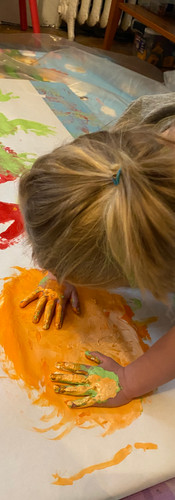Art and Autism
- Coordinator John Bryan

- Jul 13, 2020
- 3 min read
I wonder how many autism grandparents involve their grandchildren in art experiences: giving them a sketchpad and crayons, a tube of paint and a poster board, a glue stick and paper and scissors. And observing what happens.
JC and I are both artists, and JC has a long career as an art teacher of all ages. So we often do “art things” with Angelina, our 4-year-old granddaughter who is on the autism spectrum. We’ve learned that there is abundant research that confirms the widespread value of various art-based therapies for autistic persons.
Several years ago I visited a music therapy class during which a 15-year-old autistic girl spoke for the first time. Just last month a mother told me about a painting that her 12-year-old autistic son created – a painting that caused their first ever communication.
Research points to the value of the arts in enhancing verbal skills, increasing mobility, instilling a positive sense of self, understanding instructions, reducing combativeness, increasing socialization, and so much more in autistic persons of all ages. Of course every autistic person is different and there are no individual guarantees regarding specific art involvements and therapies.
JC and I are very involved as autism grandparents, but we are definitely not autism experts or “art therapy” experts. So our arts involvements with Angelina are not grounded in any structured or proven research – at least not that we know of. But we can see improvement in Angelina in three areas: dexterity (she is getting better and better in using a paintbrush, scissors, crayons, etc.); attention span (she’s progressed from 30 seconds to 30 minutes or more); and understanding instructions (for example, “put some glue on the piece of paper and then turn it over and then press it down”).
I suspect that all autism grandparents would have individually different approaches to doing art things with their grandchildren. JC and I certainly do.
Because of JC’s extensive experience teaching art to children, she knows what sorts of things work best, what sorts of things best inspire creativity, and what sorts of things enhance a child’s pride and self-worth. For example, she never does anything “for” Angelina during an art project; she allows Angelina to do it herself and thus make plenty of “mistakes.” But the end product is always totally Angelina’s. When Angelina expresses frustration at not being able to cut things properly with the scissors or squeeze the glue from the tube or anything else, JC will simply encourage her to try again – and praise her for each step in the right direction.
My methods with Angelina are pretty much opposite of those of JC, and I’m slowly trying to improve because I realize that JC’s are better. I tend to simply give Angelina some art tools (paint, brushes, giant piece of paper) and let her do whatever she wants without any guidance. And when Angelina exhibits frustration, I tend to help her by doing it for her. I’ll of course say, “Here’s how you do it.” I’m trying to learn to be more encouraging of Angelina doing hard things by herself.
Our arts involvements with Angelina haven’t resulted in any epiphanies that we’re aware of. And they are not yet activities that Angelina regularly begs for when she visits us. But we do them often and are hopeful that they are contributing to Angelina’s overall development.
If you Google “art and autism” you’ll find a huge variety of information and websites. For example, http://the-art-of-autism.com is an online art gallery and blog. Purevisionarts.org is the website of a New York City studio/gallery for autism and other developmental disabilities. And there is a comprehensive website that includes a list of art/autism related organizations all over the world: www.healing-power-of-art.org.











Comments